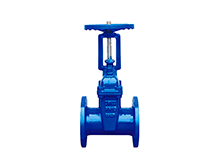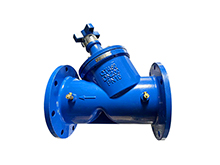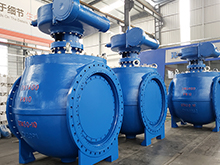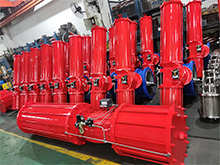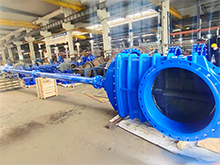- Gate valve
-
- BS5163 rising stem soft seal gate valveDN1000 Extension stem double flange soft seal gate valveWEIZIDOMDIN F4 resilient seated gate valveDN450-1200 Resilient Seated Gate ValveDIN F5 resilient seated gate valveSocket connection soft seal gate valveWEIZIDOMUnderground cap soft seal gate valveHard seal gate valveAPI slab Gate ValveStainless steel flange gate valveWafer knife gate valvePneumatic gate valveSoft seal gate valveExtension stem gate valveUL/FM fire protection groove ends gate valveRising stem forged steel gate valvecarbon steel gate valveStainless steel threaded gate valveDIN soft seal gate valveANSI soft sealing gate valve 200PSICast iron gate valveBS resilient seated gate valve
- Butterfly valve
-
- DN900 pneumatic triple eccentric hard seal butterfly valveD643H Triple Eccentric Butterfly ValveD343H Hard seal butterfly valveMulti standard EPDM seated butterfly valveSingle flange butterfly valveDN2000 Double eccentric butterfly valveFlange butterfly valveLug butterfly valveWafer butterfly valve with handleWorm gear operated butterfly valveWafer lined fluorine butterfly valveStainless steel wafer butterfly valveStainless steel flanged butterfly valveThree eccentric flange butterfly valvePneumatic flanged butterfly valvePneumatic wafer butterfly valveTriple eccentric butterfly valve wafer typeWafer butterfly valve ULC approvedInflatable seat butterfly valveHigh performance butterfly valveGrooved end butterfly valveElectric soft seal butterfly valveFlange fluorine lined butterfly valveHandle aluminum butterfly valveWorm Gear Aluminum Butterfly ValveFull PTFE lined butterfly valve wafer typeOne stem no-pin wafer butterfly valveMulti standard aluminum stem butterfly valveStainless Steel wafer Butterfly ValveAluminium handle operated lug butterfly valveLever Operated Flange Butterfly ValveButterfly valve stemButterfly valve discButterfly valve seat
- Ball valve
-
- DN1400 top-mounted eccentric semi-ball valveFlanged three-way ball valveFully welded ball valveNatural gas ball valveHigh platform flange ball valve1 PC ball valveFixed ball valvePTFE seat flanged ball valveMetal seat ball valveAPI 6D ball valve3 Piece ball valveFull Bore 3 way ball valve L-Port3 Way T-Port ball valve2PC Ball valve female thread stainless steel
- Globe Valve
-
- API Carbon Steel Globe ValveBellows Globe ValveStainless steel flange globe valveStainless steel thread S type globe valveStainless steel thread B type globe valveCast Steel Globe ValvePiston Globe ValveWCB Carbon Steel Globe Check Valveelectric motorized control stainless steel SS316 globe valveBrass Globe ValveCryogenic Globe valveHT200 Globe ValveThreaded Stainless Steel Globe ValveGG25 Globe ValveANSI API Cast Steel And Stainless Steel Globe valve
- Check valve
-
- Rubber seal check valveDN800 Slow closing check valveDN800 Rubber Disc Check ValveButterfly Buffering Check Valvecheck valve with counter weightSilent Check ValveWCB Swing check valveSwing Check ValveSingle Chip Check Valve H74WStainless Steel Wafer Check ValveSwing Start Check ValveFoot check valveAPI Swing Check ValveDIN Flange check valveSingle plate check valveLifting Check ValveBottom ValveHammer Diminish Noises Check ValveWafer Check ValveWafer dual plate check valve
- Control valve
-
- Static Balancing ValveCage Guided Sleeve Globe Control ValveDN1000 Piston Flow Regulating ValveDN1600 Electric Actuator Flow Regulating ValvePneumatic Flanged Butterfly ValvePneumatic Wafer Butterfly ValveAngle Seat ValvePneumatic gate valveElectric three-way control valveElectric sleeve control valve
- Water Meter
-
- Vertical Type Water MetersStainless steel threaded water meterPiston water meterPlastic water meterMore flow rotor dry water meterspiral vane flange water meterCI wotlman water meter with pulse outputLXCLG(R) Vertical removable element woltman cold (hot) water meterSingle flow rotor dry water meterPrepaid Token Water MeterElectromagnetic flowmeterRotary Piston Liquid Sealed Water MeterRotary Piston Liquid Sealed Water Meter
- Air valve
-
- Double ball exhaust valveDoubleair Air Valve SaudiDoubleair Air Valve Southeast AsiaDoubleair Air Valve South AmericaDouble Air ValveThreaded Air ValveSingle Air ValveTriple Functions Air ValveAutomatic Air Release ValveAutomatic release valveAutomatic exhaust valveComposite Exhaust Air ValveBrass exhaust valveDouble Ball Air Valve
- Pipe Repair & Coupling
-
- Flexible Multi-Function Pipe Coupling ZFJ-SSS Semi-Circle Pipe Repair Clamp SJW-HDuctile Iron Band Repair ClampStainless Steel Band Repair ClampDouble-Section Pipe Repair CouplingFolding Type Pipe RepairSingle-Section Multi-Function Pipe Coupling MF-SGear-Ring Type Multi-Function Pipe Coupling GR-SZBW Damping Corrugated Hose
- Dismantling Joint
-
- VSSJAFC(CC2F) Detachable Flange Transmission JointVSSJA-2(B2F) Double Flange Limited Expansion JointVSSJA-1(BF) Single Flange Limited Expansion JointVSSJA(AF) Flange Loose Expansion JointJGD-B Threaded Rubber JointZBW Damping Corrugated HoseKXT-S Flexible Dual-Spherical Rubber JointKXT Rubber Soft JointFlange Adaptor
Why Choose Stainless Steel Ball Valves?
In today’s industrial and water systems, reliability and durability are essential. Pipelines often deal with high pressure, corrosive fluids, and continuous operation. Choosing the right valve can prevent leakage, reduce downtime, and extend the service life of equipment.
A stainless steel ball valve is one of the most widely used solutions. Known for its corrosion resistance, strength, and easy operation, it plays a critical role in industries such as water supply, oil & gas, chemical processing, and HVAC.
This article will guide you through everything you need to know about stainless steel ball valves:
✔✔ What they are
✔✔ Where they are used
✔✔ Key benefits
✔✔ How to install and maintain them
By the end, you’ll understand why a high-quality stainless steel ball valve from WEIZIDOM is the right choice for your project.
What is a Stainless Steel Ball Valve?
A ball valve is a type of quarter-turn valve that controls the flow of liquid or gas using a rotating ball with a bore (hole) in the center. When the bore is aligned with the pipeline, fluid flows through; when turned 90 degrees, the flow is blocked.
A stainless steel ball valve is made of 304, 316, or 316L stainless steel, making it:
Resistant to rust and corrosion
Strong enough for high pressure and high temperature
Suitable for both water and chemical applications
Basic Structure:
Valve body – stainless steel housing
Ball – polished stainless steel for smooth rotation
Seats – PTFE or other sealing materials for tight shut-off
Stem and handle – used to rotate the ball
Seals and gaskets – prevent leakage
Applications of Stainless Steel Ball Valves
Stainless steel ball valves are versatile and used across multiple industries:
✅ Water Supply and Plumbing
Shut-off valves for water distribution networks
Protect pipelines from leakage
Long service life compared to brass valves
✅ Oil & Gas Industry
Handle crude oil, natural gas, and hydrocarbons
Withstand high pressure and temperature
Reliable sealing under harsh environments
✅ Chemical and Industrial Plants
Suitable for corrosive chemicals, acids, and alkalis
Prevent leaks in critical production processes
✅ HVAC Systems
Control chilled water and hot water loops
Reliable operation in heating and cooling plants
✅ Food and Beverage Industry
Stainless steel provides hygienic and safe operation
Easy to clean, preventing contamination
✅ Power Plants and Energy Systems
Handle steam, cooling water, and fuel lines
Ensure efficiency and safety in high-demand environments
Key Features and Advantages
✔ Corrosion Resistance – Stainless steel resists rust, acids, and chemicals.
✔ High Pressure & Temperature Performance – Suitable for demanding pipelines.
✔ Tight Sealing – PTFE seats ensure zero leakage.
✔ Easy Operation – Quarter-turn design makes operation quick and simple.
✔ Low Maintenance – Strong materials and design reduce the need for repairs.
✔ Durability – Service life is significantly longer than brass or PVC ball valves.
✔ Versatility – Works for water, oil, gas, steam, and chemicals.
Installation Guide for Stainless Steel Ball Valves
Proper installation ensures performance and safety:
✔✔ Step 1: Inspection
Check for visible damage
Ensure the valve is clean before installation
✔✔ Step 2: Alignment
Install the valve in the correct flow direction
Ensure pipeline alignment before tightening
✔✔ Step 3: Connection
Use proper gaskets for sealing
Tighten flange bolts evenly in a cross pattern
✔✔ Step 4: Operation Check
Test the handle for smooth operation
Ensure full open/close movement
✔✔ Step 5: Pressure Test
Perform a hydrostatic test to confirm no leaks
Maintenance Tips for Stainless Steel Ball Valves
✅ Regular Inspections – Check for leaks, cracks, or corrosion.
✅ Lubrication – Apply grease to the stem if necessary.
✅ Cleaning – Flush pipelines to prevent debris buildup.
✅ Handle Check – Ensure smooth rotation of the handle.
✅ Replacement Cycle – Replace seats or seals if wear is detected.
Common Problems and Solutions
✔✔ Problem 1: Leakage around the stem
Cause: Worn-out seals.
Solution: Replace stem packing or O-rings.
✔✔ Problem 2: Hard to operate handle
Cause: Debris or lack of lubrication.
Solution: Clean the valve and lubricate the stem.
✔✔ Problem 3: Internal leakage
Cause: Damaged ball or seat.
Solution: Replace ball and seat components.
Why Choose WEIZIDOM as Your Stainless Steel Ball Valve Supplier?
At WEIZIDOM, we specialize in valve and pipeline solutions, with factories across China producing stainless steel valves, ductile iron valves, flow meters, and fittings.
✔ Exported to 100+ countries
✔ 1000+ successful projects worldwide
✔ Multiple specialized factories (Wenzhou for stainless steel, Anhui for ductile iron, Tianjin for butterfly valves, etc.)
✔ OEM and customized solutions available
✔ Competitive pricing directly from the manufacturer
With years of experience in valve manufacturing, WEIZIDOM is your reliable partner for stainless steel ball valves.
FAQ – Stainless Steel Ball Valves
Q1: What is the main purpose of a stainless steel ball valve?
✔✔ To control the flow of liquid or gas with tight shut-off.
Q2: What materials are used in stainless steel ball valves?
✔✔ 304, 316, and 316L stainless steel for corrosion resistance and strength.
Q3: Where are stainless steel ball valves commonly used?
✔✔ Water, oil & gas, HVAC, chemical plants, power plants, and food industry.
Q4: How long does a stainless steel ball valve last?
✔✔ Typically 10–15 years with proper installation and maintenance.
Q5: How do you install a stainless steel ball valve?
✔✔ Align the pipeline, use proper gaskets, tighten bolts evenly, and test operation.
Q6: How do you maintain a stainless steel ball valve?
✔✔ Perform inspections, lubricate moving parts, and replace seals if needed.


